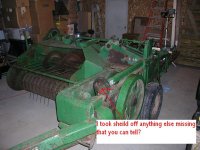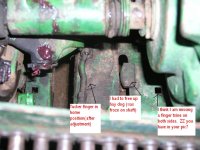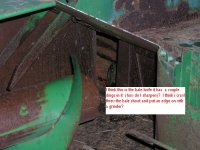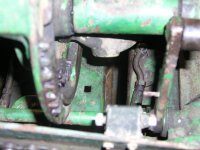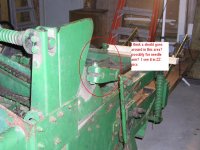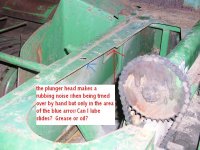You are using an out of date browser. It may not display this or other websites correctly.
You should upgrade or use an alternative browser.
You should upgrade or use an alternative browser.
I am into to it now! Jd 14t
- Thread starter BryanM
- Start date
- Views: 31238
/ I am into to it now! Jd 14t
#21
As they say a pic is worth a thousand words! thanks!!!
thanks!!!
Last night I had my wife turn over the flywheel and watched operation of the knotting assembly. Boy did that make difference having someone else turn it over, I even think I got a rough Idea on how it works.
things I did last night weither right wrong or indifferent:
1 check timing, needle travel, tucker fingers, twine holder wiper arms and greased a few more parts up.
Everything seems to be intime and working. Although I need to do some tweaking and adjusting. On my needles they are just touching the twine disk, and I did adjust a play with the tuckerfinger assembly, but I belieave the shaft is twisted yet and their are some play in fingermounting bolt holes. And one push rod is froze up on agjusting threads. I can not get my tucker fingers 1/8inch from needle slots and 3/32" from needle.
I ran twine threw one needle at a time with my wife turning the flywheel and me holding thwine and putting tension on the loop it made which would have been (kinda) simulating a bale and watched the Knotter assmbly tie a knot and cut. (by the way the knives seem to be very sharp). the twine.
that being said I have 2 questions: 1.) As the wiper arm came across the bottom bill it didnt wipe the knot all the way off the bill. (i do need to check the bill jaw tongue pressure). But also read that bale density to low. I am wondering if my simualtion of a ble didnt acheive bale density. Any Ideas
2) is where can I buy the shear bolts and nuts for the flywheel. Is that a JD item or can I get at a TSC type store?
Last night I had my wife turn over the flywheel and watched operation of the knotting assembly. Boy did that make difference having someone else turn it over, I even think I got a rough Idea on how it works.
things I did last night weither right wrong or indifferent:
1 check timing, needle travel, tucker fingers, twine holder wiper arms and greased a few more parts up.
Everything seems to be intime and working. Although I need to do some tweaking and adjusting. On my needles they are just touching the twine disk, and I did adjust a play with the tuckerfinger assembly, but I belieave the shaft is twisted yet and their are some play in fingermounting bolt holes. And one push rod is froze up on agjusting threads. I can not get my tucker fingers 1/8inch from needle slots and 3/32" from needle.
I ran twine threw one needle at a time with my wife turning the flywheel and me holding thwine and putting tension on the loop it made which would have been (kinda) simulating a bale and watched the Knotter assmbly tie a knot and cut. (by the way the knives seem to be very sharp). the twine.
that being said I have 2 questions: 1.) As the wiper arm came across the bottom bill it didnt wipe the knot all the way off the bill. (i do need to check the bill jaw tongue pressure). But also read that bale density to low. I am wondering if my simualtion of a ble didnt acheive bale density. Any Ideas
2) is where can I buy the shear bolts and nuts for the flywheel. Is that a JD item or can I get at a TSC type store?
Wow, a husband and wife team. I'm jealous.
The wiper arm is supposed to completely clean the knot off the billhook jaw. As it travels across, there is some major friction contact there,. Its not 'close', it's a tough scrape. The wiper arm is soft steel and will wear to conform to the hardened billhook. The manual shows how to "model" the wiper arm to get the job done. "model" = bend. I know it looks like cast iron, but its actually malleable iron = bendable. The working scraper should give you an idea of how much contact pressure is appropriate, but that one may be worn, too. I use 2 large Crescent wrenches to do it. One to hold the wiper and the second one on the first to twist it.
I buy shear bolts anywhere. What's important is not the strength of the bolt, but its elasticity. A shear plate action (as in flywheel against drive arm) works with the friction contact of the flywheel against the driver, not the brute strength of the bolt. Get a cheap #5 bolt, lock washer and two wrenches that will reside in the baler toolbox. Get a box of spares (dozens). Nuts and bolts. You will soon be able to change them with blindfolds on. Its not a problem when the bolt shears, it could be a heavy wet clump of hay, a tree branch, a broken bale, etc that decelerated the flywheel enough to shear it. I've often found myself running along with the tractor governor cycling a bit, then realizing the shear pin has been broken. The head/nut still sits there and looks good to go. Just when you shut down the flywheel just keeps goin' and goin' and goin' and goin' and goin'.
Its interesting to notice you use of the part names (correctly, too!). When this thread all started, sounded like you were still working on the meaning of the word 'baler'.
Now look you've gone and done !
Gonna need a picture of the wife and her first bale...
Should be worth saving. Mine is 2 flakes tied in a memorable, perfect little package. "they" said it would never work again.
"They" were wrong.
The wiper arm is supposed to completely clean the knot off the billhook jaw. As it travels across, there is some major friction contact there,. Its not 'close', it's a tough scrape. The wiper arm is soft steel and will wear to conform to the hardened billhook. The manual shows how to "model" the wiper arm to get the job done. "model" = bend. I know it looks like cast iron, but its actually malleable iron = bendable. The working scraper should give you an idea of how much contact pressure is appropriate, but that one may be worn, too. I use 2 large Crescent wrenches to do it. One to hold the wiper and the second one on the first to twist it.
I buy shear bolts anywhere. What's important is not the strength of the bolt, but its elasticity. A shear plate action (as in flywheel against drive arm) works with the friction contact of the flywheel against the driver, not the brute strength of the bolt. Get a cheap #5 bolt, lock washer and two wrenches that will reside in the baler toolbox. Get a box of spares (dozens). Nuts and bolts. You will soon be able to change them with blindfolds on. Its not a problem when the bolt shears, it could be a heavy wet clump of hay, a tree branch, a broken bale, etc that decelerated the flywheel enough to shear it. I've often found myself running along with the tractor governor cycling a bit, then realizing the shear pin has been broken. The head/nut still sits there and looks good to go. Just when you shut down the flywheel just keeps goin' and goin' and goin' and goin' and goin'.
Its interesting to notice you use of the part names (correctly, too!). When this thread all started, sounded like you were still working on the meaning of the word 'baler'.
Now look you've gone and done !
Gonna need a picture of the wife and her first bale...
Should be worth saving. Mine is 2 flakes tied in a memorable, perfect little package. "they" said it would never work again.
"They" were wrong.
Robert_in_NY
Super Member
- Joined
- Aug 1, 2001
- Messages
- 8,552
- Location
- Silver Creek, NY
- Tractor
- Case-IH Farmall 45A, Kubota M8540 Narrow, New Holland TN 65, Bobcat 331, Ford 1920, 1952 John Deere M, Allis Chalmers B, Bombardier Traxter XT, Massey Harris 81RC and a John Deere 3300 combine, Cub Cadet GT1554
Z, you need an older JD to power the baler as your tractor just doesn't look right in front of that baler
I am enjoying this thread as I have an idea how my knotters work from walking beside the baler while my dad baled for me one day. I don't remember how many bales went thru it but it was fun watching them work like they were suppose to. Every time it cycled I was amazed at who ever designed this system as it looks so complicated yet works perfectly smooth.
Has Japan even been able to make a robot that can tie knots yet? I guess that is what always amazed me that a machine being able to tie knots and it has been around long before me.
Bryan, when you get this baler going please take pictures of your operation in the field. I have been doing this for a few years and I am usually by myself except for baling so I have plenty of baling pictures but no raking or tedding and only a couple cutting. As I update equipment I want to be able to go back and look at pics of equipment I use to run.
I really want that old Case baler now because this thread is making me want an older baler and there is a thread about identifying a old tractor that ends up being a Case model S tractor. I wish I was healthy so I could play in the barn as you guys are making me miss it even more
Best of luck to you.
Robert
I am enjoying this thread as I have an idea how my knotters work from walking beside the baler while my dad baled for me one day. I don't remember how many bales went thru it but it was fun watching them work like they were suppose to. Every time it cycled I was amazed at who ever designed this system as it looks so complicated yet works perfectly smooth.
Has Japan even been able to make a robot that can tie knots yet? I guess that is what always amazed me that a machine being able to tie knots and it has been around long before me.
Bryan, when you get this baler going please take pictures of your operation in the field. I have been doing this for a few years and I am usually by myself except for baling so I have plenty of baling pictures but no raking or tedding and only a couple cutting. As I update equipment I want to be able to go back and look at pics of equipment I use to run.
I really want that old Case baler now because this thread is making me want an older baler and there is a thread about identifying a old tractor that ends up being a Case model S tractor. I wish I was healthy so I could play in the barn as you guys are making me miss it even more
Best of luck to you.
Robert
Thanks for the support guys. And hopefully I can get this one baling? I just got back from getting a few nuts and bolts for it. I have noticed that mine is missing some parts that ZZ has. One thing I noticed that was missing was down next to the trip dog(I think it is called finger twine. What does this do? Do I need it? 2nd thing is well I have no idea what it is it on zz's a round circle directly back from flywheel around area of the feeder forks. I need to get a pic and point it out because my description is awful.
Good thing ZZ said to check the hay dog cause the center one was tied up on its shaft not allowing it too return or move freely. I will get some pics of the things I think I am missing later tonight. O one more thing I thing I am choosing to go with the plastice twine, is their a spec I should get? Tsc had some real thick stuff and thinner stuff not sure on which one to get?\
Robert wish ya could be hear to help and ZZ I really wish you could be here! Cause I still feel like I am missing something
Good thing ZZ said to check the hay dog cause the center one was tied up on its shaft not allowing it too return or move freely. I will get some pics of the things I think I am missing later tonight. O one more thing I thing I am choosing to go with the plastice twine, is their a spec I should get? Tsc had some real thick stuff and thinner stuff not sure on which one to get?\
Robert wish ya could be hear to help and ZZ I really wish you could be here! Cause I still feel like I am missing something
One plastic type is for round balers, the other is for square balers. Round balers use more twine loops so they can use lighter strength twine. The box will say what its for. I believe the square is BT-120. The spools are the same dimenstion and you can bale with either. Just don't throw them down from a hay mow 'cause they will break when they hit the ground (if you use the light duty twine).
READ the manual. The plastic takes some tighter tension in 2 places: twine box outlet and twine holder disks.
Get a cheap fish scale that can read 0 - 20 lbs. That's the standard for setting the tension: Look up the readings in the manual.
I suspect the thing you are wondering about may be a drive shaft extention for coupling up a bale ejector to the hay chute to toss a completed bale onto a following hay wagon.
Being near a TSC is handy. They have chain, sprockets, bolts & nuts, paint, tires, tubes, pickup tines (sometimes), and other things you need for the mower and rake: teeth, bearings, belts, grease, knives, attractive help and other benefits.
Where huzacktly are you be located, anyways? I'm in SE Michigan (Brighton).
A road trip a few hundred miles is called a weekend jaunt for me and my all black children.
READ the manual. The plastic takes some tighter tension in 2 places: twine box outlet and twine holder disks.
Get a cheap fish scale that can read 0 - 20 lbs. That's the standard for setting the tension: Look up the readings in the manual.
I suspect the thing you are wondering about may be a drive shaft extention for coupling up a bale ejector to the hay chute to toss a completed bale onto a following hay wagon.
Being near a TSC is handy. They have chain, sprockets, bolts & nuts, paint, tires, tubes, pickup tines (sometimes), and other things you need for the mower and rake: teeth, bearings, belts, grease, knives, attractive help and other benefits.
Where huzacktly are you be located, anyways? I'm in SE Michigan (Brighton).
A road trip a few hundred miles is called a weekend jaunt for me and my all black children.
I am located little east of toledo, (elmore, 43416) if your curious. I ended up drilling out one of the knives(rivets) finally got them out. Will John deere have a set of twine knives for this? I ended up getting an el-cheapo fish scale and testd out the fingers. They where set at the start of opening at 17lbs and about 20lbs to get an 1/8". I backed the tension off to start opening at about 8lbs. then I adjusted the wiper arm where it hits the bill easy on one side the had a plate with screws in it to adjust same with knife.
On the right side however as I was adjusting the wiper arm to the bill I noticed the knife was cracked, well I finished it off. so I had to grind of the rivets. thats where I am at. Well I think I am done for tonight will load pics tommorrow. thanks
On the right side however as I was adjusting the wiper arm to the bill I noticed the knife was cracked, well I finished it off. so I had to grind of the rivets. thats where I am at. Well I think I am done for tonight will load pics tommorrow. thanks
Here are a few pics and questions? 

I put down a few questions in the pics: Plus I think I can still order a few parts from JD like twine knifes I think or is their a better place to get parts?
So far I am having a good time tinkering with this old baler, and asking you guys questions. Thanks again I promise to slow down on the questions as soon as I get a handle on things!
I was wonering when I get things adjusted should I get a tractor and hook it up and throw a few pieces of hay into it? Wood that work to tell me if it is operational?
I put down a few questions in the pics: Plus I think I can still order a few parts from JD like twine knifes I think or is their a better place to get parts?
So far I am having a good time tinkering with this old baler, and asking you guys questions. Thanks again I promise to slow down on the questions as soon as I get a handle on things!
I was wonering when I get things adjusted should I get a tractor and hook it up and throw a few pieces of hay into it? Wood that work to tell me if it is operational?
Attachments
1 If the wipers arms are not of the adjustable type, then you adjust by bending then, As I mentioned previously, use 2 Crescent wrenches: 1 to hold the wiper arm and one to twist the other wrench. Be creative. Or you can pull the Cotter pin and pull out the arm and do it in a vise with several iterations. Watch spacer locations. Getting the arm back in has always been a puzzle for me, like snaking a sewer.
2 Yes I see that someone swiped your toolbox. Make a new one out of an ammunition box. Its airtight. The area in front of the feeder forks is the dirtiest, dustiest part of the running machine.
3 I see you need a deadbolt lock on that back door.
4 Before you hook up tractor power, set the tongue straight, that is not a CV driveline.
5 You are not missing anything from those square bolt holes. I believe they are for adding extra hay flake holdback shields use when doing very light grass and leaves.
6 Yes you can crawl in there with a grinding wheel and sharpen both cutting knives. There are some flathead screws use to hold them. I never bothered to get them loose. If you have a hammer powered screwdriver, that might work. Need a large one, though.
7 Grease the rubbing parts. Thats what they are there for. Plunger has cast iron rubbing blocks on it to hold the plunger in lateral and vertical position. Newer balers use ball bearing races.
8 Yes a shield was there. If the knotter trips while you are there working on it, the needle lift will chop your arm off on the upstroke. Its a clean cut, so just save the parts and have the Doc sew it back on, especially if its your bathroom wiper arm.
9 Looks like the needle brake compression springs are coil bound, Either they are shot and it took a lot of thread to get some damping or someone has a bit too much wisdom in there. Use your fish scale to measure needle lift force as the manual shows. As in NASCAR, coil binding gives the vehicle some great signals as to where max grip is, but some drivers just can't get the hang of it.
10 Looks like those are all the original chains. As long as they are not stretched, they are good to go. If stretched by a jerk (or a Jerk), they will wear out the sprockets. If a chain breaks and the thing looses time, you will need a new pair of needles or a good welder. Use a dry lubricant on the chains. Grease + hay chaf = grinding wheel class abrasive. I just let mine run dry. Many new chains are oil impregnated, anyways.
That's my top 10. Get some good hay bales (3 or 4 ). load the twine. Fire it up, toss in some hay and cross you fingers. When operating, the bale case holds 2 or 3 complete bales. Don't adjust the measuring wheel or bale tension (unless you backed the screws completely out) until you have made a round out in the center of the field.
2 Yes I see that someone swiped your toolbox. Make a new one out of an ammunition box. Its airtight. The area in front of the feeder forks is the dirtiest, dustiest part of the running machine.
3 I see you need a deadbolt lock on that back door.
4 Before you hook up tractor power, set the tongue straight, that is not a CV driveline.
5 You are not missing anything from those square bolt holes. I believe they are for adding extra hay flake holdback shields use when doing very light grass and leaves.
6 Yes you can crawl in there with a grinding wheel and sharpen both cutting knives. There are some flathead screws use to hold them. I never bothered to get them loose. If you have a hammer powered screwdriver, that might work. Need a large one, though.
7 Grease the rubbing parts. Thats what they are there for. Plunger has cast iron rubbing blocks on it to hold the plunger in lateral and vertical position. Newer balers use ball bearing races.
8 Yes a shield was there. If the knotter trips while you are there working on it, the needle lift will chop your arm off on the upstroke. Its a clean cut, so just save the parts and have the Doc sew it back on, especially if its your bathroom wiper arm.
9 Looks like the needle brake compression springs are coil bound, Either they are shot and it took a lot of thread to get some damping or someone has a bit too much wisdom in there. Use your fish scale to measure needle lift force as the manual shows. As in NASCAR, coil binding gives the vehicle some great signals as to where max grip is, but some drivers just can't get the hang of it.
10 Looks like those are all the original chains. As long as they are not stretched, they are good to go. If stretched by a jerk (or a Jerk), they will wear out the sprockets. If a chain breaks and the thing looses time, you will need a new pair of needles or a good welder. Use a dry lubricant on the chains. Grease + hay chaf = grinding wheel class abrasive. I just let mine run dry. Many new chains are oil impregnated, anyways.
That's my top 10. Get some good hay bales (3 or 4 ). load the twine. Fire it up, toss in some hay and cross you fingers. When operating, the bale case holds 2 or 3 complete bales. Don't adjust the measuring wheel or bale tension (unless you backed the screws completely out) until you have made a round out in the center of the field.

